|
|
|
|
Contact:
aka Esbit Stoves and Hexy Burners
Burners for solid fuels such as ESBIT (Erich Schumm Brennstoff In Tabletten - Erich Schumm fuel in tablets) accomplish several things. They help prevent your melting fuel tab from soaking into the ground, reflect some of the heat radiating towards the ground back up at your stove, keep your fuel dry, protect the ground from the residue that remains after the fuel has burned, elevate the fuel closer to your pot when using a pot stand made for multiple fuel types (alcohol, wood, etc), increase surface area of fuel exposed to air, and may be considered a stove where campfires are prohibited.
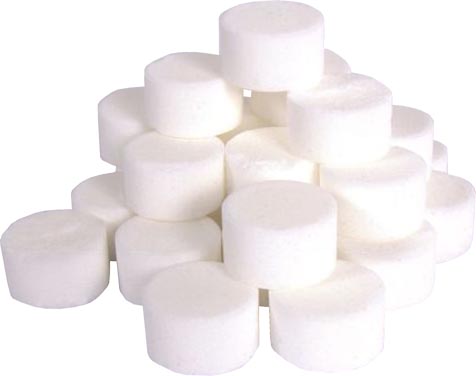
Solid fuels come in many different shapes, sizes and chemical compositions. More information about specific fuels such as Hexamine, Trioxane, META, Dry Spirit, Fuel Paste, Wood and Biomass and Candle fuels are found below.
Solid Fuel Burners
Burners for solid fuels come in many forms. Here are a few simple burner options to give you an idea of what might work for you.
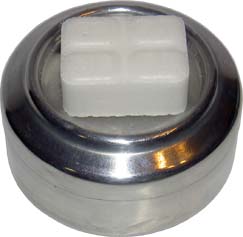
Flip over an alcohol stove made from beverage cans and place fuel tab on stove bottom. You now have two stoves in one.
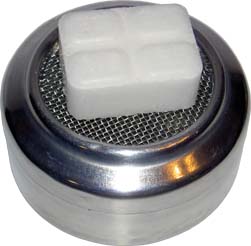
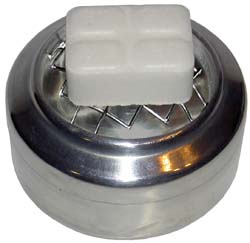
Cut out a circular piece of stainless mesh or welded wire and fit it to the bottom of the stove. This allows for better air contact with your solid fuel tab and looks neat. See Templates for circle template.
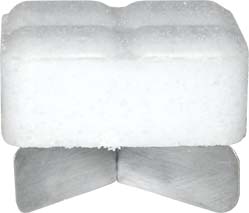
The X holder above is just big enough to hold one Esbit on it. This one isn't very durable by any means, but it doesn't need to be and this one doesn't have any significant weight to it. See Templates.
Cut out a piece of foil and place it on the ground. This will reflect some of the heat from your heat tab back up toward the pot and protect you fuel from the wet ground.
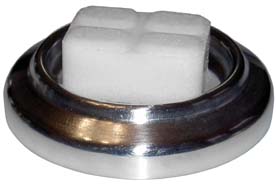
If you would like something sturdier than a piece of foil, you can trim down a bottom from a 12oz drink can. You can stack an X holder or steel mesh on this if you would like to increase the surface area of your fuel tab in contact with air.
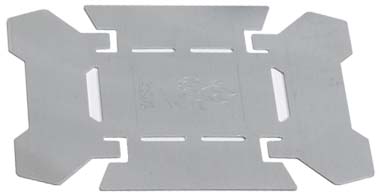
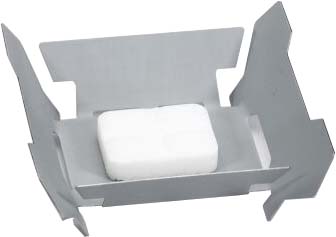
In French military rations is a sheet of galvanized steel that folds into a hexamine stove. 11.5 x 8.8cm

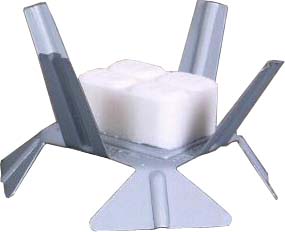
Another foldable piece of galvanized steel is Esbit's Star Cooker. 8.5 x 8.5cm
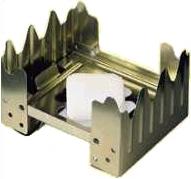
There are several commercial and military (UK) foldable steel stoves that are a bit heavy but also very durable and serves as a pot stand. They generally weigh around 3oz (3" x 4" x 3/4" folded) or more depending on size and construction. See US Patent 2,414,490.
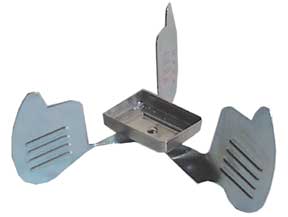
The 1.3oz wing stove folds up to 3" x 2" x 1" and also functions as a pot support. A 0.3oz titanium version can also be purchased online or made.
Note - Titanium can tear if you bend it too far when cold. You may need to limit bending to 45° or use a torch to heat up your metal before bending it. See thru-hiker.com's 0.3 oz Titanium Wingstove and templates for more information.
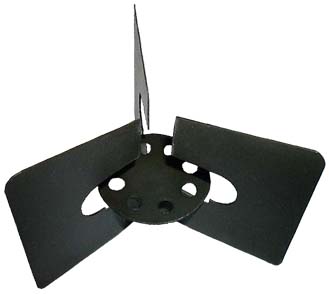
A Tommy Cooker was used by British forces during WW2 how needed a smokeless cook system. It's a simple tripod design similar to today's wing stoves but made for larger tea kettles.
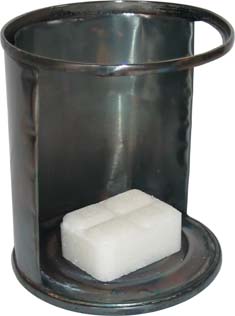
An Outback Hexi Stove is made by using a can opener to remove the top of a tin can (military beans), cutting half circumferentially on the side of the can along the top and bottom rim and folding the side of the can inwards. Many usable variants can be made, including more stable ones with more than one support.
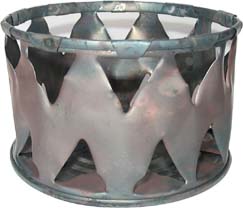
A C Ration Stove is made by opening up a tin can (Crackers cans are less greasy than Eggs and Ham) and punching holes in the side of the can with a church key.
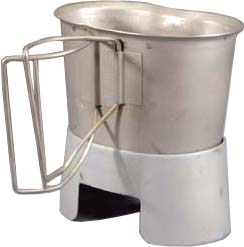
Weighting between 5oz (aluminum) and 11oz (steel) is the US GI Canteen Cup Stand. This stand is made for a military canteen cup and fits around a military canteen for storage. See US Patent 2,386,501 2,502,434.
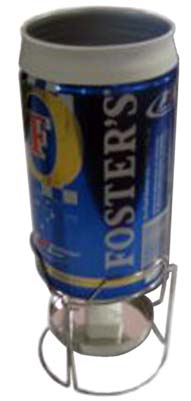
Ultralight Outfitters Beercan Esbit Stove System
Reported as weighing in at 3.8oz, this commercial Beercan Esbit System is a lightweight option from those who are willing to use a Can-Pot but aren't too excited about designing their own pot stand. See US Patent Application 2005/0217657 A1.

A simple to make beercan system that weighs in at about 2oz. There are many variants of this stove. See Pot Stands for more ideas and info on various DIY pot stands.
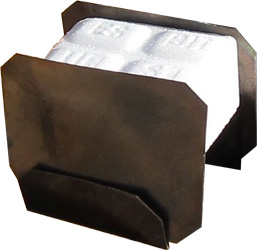
3gram titanium Gram Cracker
Rand Lindsly of Trail Designs points out their view on burning solid fuel. They feel that if you allow Esbit to burn on a conventional Esbit burner, it will burn on all exposed sides and release more heat than your pot can absorb. This is a waste of fuel in the beginning, and as the fuel is consumed, its surface area decreases which makes for a decreasing burn rate over time.
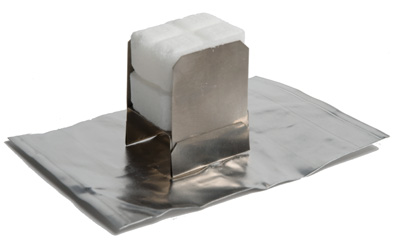
2 ESBITs on Gram Cracker stand
Note the sidewalls of stove are set vertically
Their titanium "Gram Cracker" stove uses removable and adjustable sides which cover the long sides of an Esbit. This blocks off 3 of the 6 sides of an Esbit which reduces the burn rate of this fuel. This in theory will allow more of the total heat released from burning your Esbit to heat your pot. And at 3 grams, it doesn't sound all that bad. Here is their video. Rand also points out that their Cone Windscreen will help maximize efficiency of burning Esbit. Also see US Patent 2,639,704 and briangreen.net titanium-foil-esbit-tray-stove.
To keep fuel residue off of your stove, you can place a piece of foil or a coin under your fuel tab. Alternately, you can pour a bit of alcohol on your stove and pot and let it sit for a while to help clean it off. Used teabags may also help breakdown the goo.
Discussion and related Links:
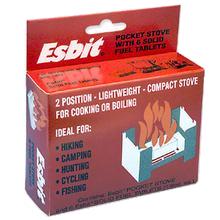
Esbit is a great simple fuel that has many benefits for ultralightweight hikers. It's simple to use, doesn't require a heavy stove and is very light. Unfortunately, there are some drawbacks. They coat the bottom of your pot and stove with brown goo, and although said to be nontoxic, the idea of getting it in your pack and pot is less than ideal to those paranoid about chemicals and messes. The burnt residue does come off easily with a little scrubbing and you can put your pot and stove in separate Ziploc bags to protect the contents of your pack. Esbit and other solid fuels often produce a noticeable odor, despite their manufacturers' claims of being odorless.
Although Esbit is generally what the hiking community thinks of when considering solid chemical fuels, there are many other brands and types of solid fuels out there. The following lists and describes just some of the solid fuels available to hikers.
Esbit and other solid fuels
Hexamethylenetetramine: aka - Hexamine, Hexy, Hexi, Hexie, Methenamine (Esbit), Hexamethylenetetramine, 3,5,7- Tetraazaadamantane, Ammonioformaldehyde, Aceto HMT, Aminoform, Ammoform, Cystamin, Cystogen, Esametilentetramina (Italian), Formamine, Formin, Hexaform, Hexamethylenamine, Urotropin, Hexamethyleneamine, Hexamethylenetetraamine, Hexamethylentetramin (German), Hexamethylentetramine, Hexilmethylenamine, HMT, Methamin, Resotropin, Uritone, Urotropine, Esametilentetramina (Italian), 1,3,5,7-Tetraazatricyclo[3.3.1.1(3,7)]decane and C6H12N4.
Note: Hexamethylenetetramine releases formaldehyde, ammonia, carbon oxides, hydrogen cyanide and nitrogen oxides when burned. It is also used as a urinary tract infection antiseptic and in explosives.
Reportedly - in 1986, the U.S. Army stopped using Hexamine fuel since they believed that Hexamine combustion could emit unsafe levels of Hydrogen Cyanide gas (HCN) in small 2-man tents.
Related Articles:
Dreyfors JM, Jones SB, Sayed Y. Hexamethylenetetramine: a review. Am Ind Hyg Assoc J. 1989 Nov;50(11):579-85.
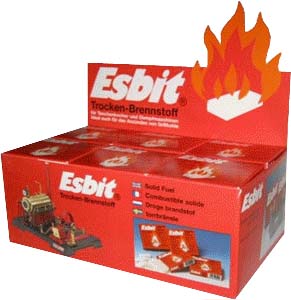
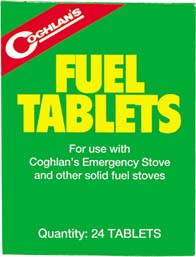
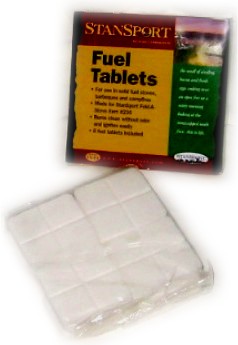

Hexamine can be purchased from many different manufactures in various shapes and sizes. This fuel is generally advertised as a "safe, clean burning fuel, easy to ignite, smokeless, odorless and non-toxic." All produce an odor, and are not always easy to ignite. In some cases, you may need to pour a little alcohol on your fuel tab to get it started.
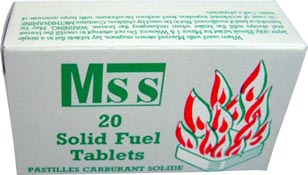
Hexamine is also used to fuel model steam engines and is sold under different names and brands. This is often referred to as Dry Spirit (see below) or Pastilles Carburant Solide.
UK military Hexamine Tabs
US military Hexamine Tabs
Not all fuel tabs are created equal. Although the many different brands of Hexamine share the same main ingredient, they vary in quality and may use different binding agents. Non-Esbit Hexamine can be found in many stores such as Trailquest (Web Archive), LWgear and military surplus stores (in a white, olive or brown cardboard tube).
Author's take on four common Hexamethylenetetramine Solid Fuel products:
Esbit
HQ Company Hexamine
StanSport Stove Fuel Item #236
Coghlan's #9565 Fuel
TabletsOne tab weighs ~14gm (~0.5oz)
Four tabs weighs ~15gm
One tab weighs ~18gm (~0.6oz)
Two tabs weigh ~13gm (0.47oz)
One tab will get 16oz of water to a good boil with the 2oz Esbit system.
Four tabs will get 16oz of water to a slight boil.
Esbit burns just about completely, except for the sticky residue left behind on the stand and pot.
Tabs leave behind a black skeleton of incompletely burned material, and you may have to poke it with a stick to expose unburned fuel in order to get it to burn all usable fuel.
Cost about US$6 for a box of 12 individually wrapped tabs.
Cost about US$1.30 for a blister pack of 8 (US$7.80 for 48 ~ 12 Esbit tabs).
Cost about US$3 for a package of 8 tabs ( ~ 10 Esbit tabs).
Cost about US$4 for a box of 24 individually wrapped tabs ( ~ 12 Esbit tabs).
US$35.71 per kg
US$43.33 per kg
US$20.83 per kg
US$25.64 per kg
Produces smoke.
Produces smoke.
Produces odor.
Produces odor.
Note: According to the Trailquest (Web Archive) site, one 1/4oz Coghlan's fuel tab (comparable to half an Esbit in weight) can boil 16oz of water. If this is correct, under ideal conditions the amount of Coghlan's fuel tabs needed would weigh half as much and cost a third of that of Esbit. Sounds too good to be true but worth investigating.
Trioxane: aka - triox, GI fuel tabs, metaformaldehyde, trioxane,1,3,5-trioxacyclohexane, 1,3,5-trioxane, aldeform, formagene, marvosan, s-trioxane, s-trixane, sym-trioxane, triformol, trioxymethylene and C3H6O3.
NOTE: These fuel tabs contain metaformaldehyde which is toxic and releases formaldehyde gas (also toxic) when it decomposes. This fuel is toxic despite the many websites that claim theirs are "nontoxic". You shouldn't eat without first washing your hands after handling this fuel and the fumes aren't much fun either.
The US military uses trioxane fuel bars which are cheap (you can buy cases of 750 from many surplus dealers) and are said to have "an almost infinite shelf life." Because of this, they are great for survivalists who want to store large amounts of supplies that are easily procurable and economical (GI surplus is a also a plus with many of these folks). Trioxane has about half the potential heat value per ounce than hexamine but burns a light blue which is more tactically sound than the bright yellow of hexamine.
NOTE: The Trioxane used in antimalarial agents is 1,2,4-Trioxane and is structurally different than Trioxane Fuel tabs.
Metaldehyde: aka - META, meta-fuel, スイスメタ [Swiss Meta], r-2, c-4, c-6, c-8-tetramethyl-1,3,5,7-tetroxocane, 2,4,6,8-tetramethyl-1,3,5,7-tetraoxocanemetacetaldehyde and C8H16O4.
This type of fuel tablets are not as commonly available as hexamine or tiroxane. META is used for lamps, small stoves, fire-starters and to preheat petrol stoves. It is made by the by the Lonza Group (Switzerland) and can be found in Europe and Japan.
This fuel is moderately poisonous and has caused death in many domestic pets and wildlife. It is in fact now most commonly used as a pesticide against slugs.
Solid Alcohol: aka - Dry Spirit, Waxed Solid Fuel, Pastilles Carburant Solide, Flaming Solid Alcohol, stearyl alcohol, octadecanol, 1-octadecanol, octadecyl alcohol, メタノール (methanol).
Solid alcohol fuel is generally considered safer to use than liquid alcohol as it has much less of a spill hazard potential. These fuels range from pure solid alcohol to solid compounds to waxy semisolid forms to gel structures. And depending on makeup, they may be free standing, wrapped in shrink wrap with or without foil, sealed in thin plastic containers or stored in metal tins.
American Gelled Alcohol
Gelled alcohol is the most commonly used form of "solid alcohol." It generally an alcohol of blend of alcohols trapped in a chemical matrix - forming a gel. It must be stored in an airtight container (generally metal). More information on this may be found on the Gelled Alcohol Stoves page.
Chinese Solid Alcohol
"Flaming" solid alcohol is a solid alcohol made from carbinol, ethanol and "condensate." It is widely used in Asia as a safe alternative to liquid alcohol fuel (which causes a high number of burns each year). Since it is more of a solid than gelled alcohol and sublimes rather than melts, it does not require a metal container to contain it.
Japanese Waxed Methanol
Another popular cooking fuel in Asia is shrink-wrapped solid alcohol with foil wrapped around the bottom. The plastic not only protects the fuel for drying up, but is also flammable to help the fuel ignite. These are packed 10 per airtight bag. These are very common to see these in use in restaurants and hotels in Japan. For our Japanese speakers, here is a copy of the paper that came with the package.
Although this fuel works rather nicely and is easy to find in Japan, it tends to dry out rather rapidly over time and is not a good choice if you don't plan on using it within a month time.
Stearyl Alcohol
Stearyl Alcohol and other large chained alcohols are often solid at room temperature and is quite flammable.
META by LONZA Ltd had an alcohol fuel in a tube made from ethylene added to alcohol which had a calorific value of about 6000kcal/kg. US Patent Number 3964880.
One fuel includes waxed solid fuel tablets or "Dry Spirit." These are often used by miniature steam engines and are more common in Europe and Asia than in the USA. It can be difficult to determine what a fuel is made of as the term "Dry Spirit" is often used to describe hexamine fuels such as Esbit. It is not clear if the above fuel is a solid alcohol or hexamine.
Another method of solidifying alcohol involves mixing it with stearin and sodium hydroxide. This has been used in the days of old in Europe and can be made at home pretty easily if you don't mind working with sodium hydroxide (lye) in your kitchen.
Homemade Solid Alcohol:
Note: the following recipes involve use of sodium hydroxide, which is a very caustic material and is very dangerous to work with. Please read up on this chemical prior to conducting any experiments and take precautions to protect exposed skin and eyes. This recipe is rather dangerous and can cause an explosion - showering the cook with very dangerous chemicals. Do so at your own risk.
Precautions:
Read up on soap and candle making prior to working with lye.
Always wear gloves and goggles when working with lye
Never pour water into lye.
If you use water with lye - Never use warm or hot water with lye. Ideally use 50% ice with water.
Never use tin, zinc or aluminum with lye.
Have vinegar available to douse skin if lye comes in contact with it.
Prevent overheating of fuels - as this can cause a fire and/or explosion.
Option 1:
US Patent 4436525 describes instruction of a solid alcohol used of firewood starting that leaves a 6% residual.
Ingredients (all ingredients are anhydrous):
67.7 parts Methanol
26 parts Isopropanol
5.5 parts Stearic Acid
0.8 parts Sodium Hydroxide (aka - NaOH, lye or caustic soda)
Directions:
Make a 10% NaOH/methanol solution - 10 gms of NaOH are dissolved in 90 gms of methanol
Warm solution to 100°F
Stearic acid is added to isopropanol and remaining methanol and heated to 140°F (stearic acid should melt)
Add NaOH/methanol mixuture to stearic acid/alcohol mixture and mix
Pour in molds
Option 2:
This is mentioned on the internet Web Archive.
Ingredients:
100 units of alcohol
10 units of stearin (glyceryl ester of stearic acid) powder or finely chopped flakes (sold as candle/soap making material or can be made from edible 100% stearin candles)
3 units of Sodium Hydroxide. Lye may also be homemade with certain wood ashes and distilled water.
Directions:
Create a water bath to heat your ingredients without overheating them (which could cause an unexpected fire or explosion). This is done by placing a smaller pot (should not be aluminum) within a larger pan or pot filled with water. The larger pan/pot is heated which in turn heats the smaller pot floating in the heated water.
Add your sodium hydroxide and stir.
Add your alcohol to the smaller pot and slowly add stearin to allow it to melt.
Pour your solution into a non aluminum container and allow it to cool down and harden.
Fuel Paste: aka - Fire Paste, Fire Starting Ribbon, etc.
Often used for starting fires or preheating liquid stoves. These pastes can and have been made from many different ingredients.
Wood Products/Biomass: aka - Wood, paper, coal, charcoal, pressed wood and wax fire starter, Lightnin' Bug Fire Starters, etc.
More information on these can be found in the Wood Stove section of this site.
Candle/paraffin and wax fuels: aka - candles, ect.
More information on these can be found in the Candle Stove section of this site.